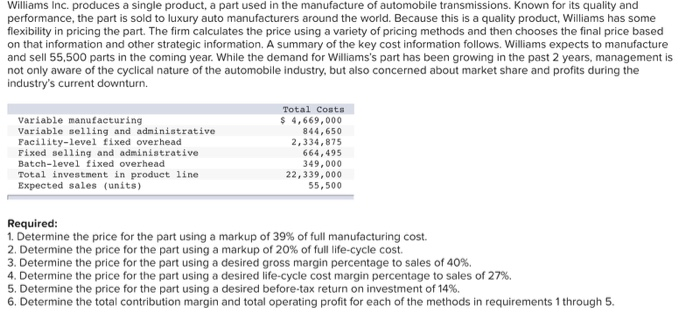Williams Inc. produces a single product, a part used in the manufacture of automobile transmissions. Known for its quality and performance, the part is sold to luxury auto manufacturers around the world. Because this is a quality product, Williams has some flexibility in pricing the part. The firm calculates the price using a variety of pricing methods and then chooses the final price based on that information and other strategic information. A summary of the key cost information follows. Williams expects to manufacturee and sell 55,500 parts in the coming year. While the demand for Williams's part has been growing in the past 2 years, management is not only aware of the cyclical nature of the automobile industry, but also concerned about market share and profits during the industry's current downturn. Variable manufacturing Variable selling and administrative Facility-1evel fixed overhead Fixed selling and administrative Batch-level fixed overhead Total investment in product line Expected sales (units) Total Costs $ 4,669,000 844,650 2,334,875 664,495 349,000 22,339,000 55,500 Required I. Determine the price for the part using a markup of 39% of full manufacturing cost. 2, Determine the price for the part using a markup of 20% of full life-cycle cost. 3, Determine the price for the part using a desired gross margin percentage to sales of 40%. 4. Determine the price for the part using a desired life-cycle cost margin percentage to sales of 27%. 5. Determine the price for the part using a desired before-tax return on investment of 14%. 6. Determine the total contribution margin and total operating profit for each of the methods in requirements 1 through 5 Required 1 Required 2 Required 3 Required 4 Required 5Required 6 Determine the price for the part using a markup of 39% of full manufacturing cost. (Do not round intermediate calculations. Round your answer to 4 decimal places.) per unit Required 1 Required 2 Required 3 Required 4 Required 5 Required 6 Determine the price for the part using a desired gross margin percentage to sales of 40%. (Round your intermediate calculations and answer to 4 decimal places.) per unit Required 1 Required 2 Required 3 Required 4 Required 5Required 6 Determine the total contribution margin and total operating profit for each of the methods in requirements 1 through 5. (Round your intermediate calculations to 4 decimal places and final answers to the nearest whole dollar amount.) Method Contribution Margin Operating Profit Markup on full manufacturing cost Markup on life cycle costs Price to achieve desired GM % Price to achieve desired LCC % Price to achieve desired ROA of 14% Required 5













